11 August, 2003
I awoke today to find the Palmer on station during a CTD cast of the
rosette. That's nothing new, of course, since we are approaching our
300th of the cruise. And the scientists will be on the rosette
drawing their water samples and down-loading the LADCP data within
minutes of its recovery in the ship's Baltic Room. But there is
another group of talented and hard working individuals that
contribute to each cast's success, namely, Raytheon's technicians and
analysts.
Before every cast, two or more of these technicians scrutinize all of
the rosette's scientific apparatus as well as prepare each water
bottle for "firing" at the appropriate depth. Repairs are made if
necessary, sensors and cables are inspected, and the rosette is
cleaned from any foreign material that may have been brought-up with
the previous cast.
Once the rosette is ready, the marine technicians must coordinate
with the bridge and one of the ship's winch operators to successfully
conduct the cast as they help guide the rosette and all of its
equipment out the Baltic Room door and into the water off the
starboard side. During this time, they monitor the angle on the
rosette's wire, which may last up to 4 hours or more for deep water
stations, making sure that every thing proceeds as it should.
Sometimes they must lean out the door over the water to push chunks
of ice with a long pole that may have drifted into the wire holding
the rosette that is below the surface. Should anyone worry, they
always wear flotation gear, safety lines, and hard hats while
performing these difficult tasks in sub-freezing conditions. And
every so often, after already completing the work described above,
they must head outside on deck to deploy the Bongo Net. These casts
go to either 100 or 1000 meters depending on the water's depth. Not
only is it very cold out there in the wind, but handling the rather
fragile net always involves lots of icy water and even some
unpleasant slime (plankton or jellyfish).
What I described above, however, is largely what I see them doing
from my perspective on the science team which is usually when we're
finishing-up with drawing our water samples. Before we are even
done, the Raytheon technicians have already arrived in the Baltic
Room to get the rosette in order for the next cast.
As you might suspect, there is a lot more going on behind the scenes.
There are two electronics technicians that take care of most of the
instruments and cable connections that go into the various lab areas.
They often have to replace various apparatus on the rosette depending
on the nature of the cast which in turn means the new gadgets have to
be checked-out to ensure everything is connected correctly. There is
also an analyst that runs the Palmer's multi-beam sonar system which
charts the sea bottom as we go and produces some interesting maps in
the process. And a network administrator troubleshoots and maintains
the ship's computers, e-mail, and data archiving. There's even a
marine "science" technician that helps to keep the ship's chemical
stores and laboratory areas in order. (I also want to apologize in
advance because I know that there's much more to what they do than I
described here.) And there is quite a bit of overlap with each
helping the other and so on.
Perhaps most remarkable, however, is that these intrepid Raytheon
technicians labor under some fairly harsh conditions for long hours
at a time, but not once, not one single time, have I ever heard one
them complain or voice some disgruntlement. Indeed, at least one
technician's near continuous laugh throughout each cast can be heard
by whales in Hawaii. Plainly put, these folks really enjoy what they
do. All of the Raytheon workers, without exception, talked about how
much they liked the travel and being out to sea. Antarctica, in
parcticular, was high on everyone's list. Many of them will be
heading down there this coming winter; that is, for the Antarctic
summer.
Herewith is a little about the Raytheon technicians themselves:
1. Jesse Doren, a marine technician from Colorado that has
worked several years for Raytheon and parcticipated in nearly 30
cruises of one kind or another;
2. Jenny White, a marine technician from California with a
degree in Molecular Biology that worked as a scientist in Antarctica
while studying phytoplankton that entailed SCUBA diving under the ice
before working on the Palmer;
3. Emily Constantine is parcticipating as an intern marine
technician from New York that is completing her geology degree at
Colgate University and previously collected sediment cores in
Antarctica on the Palmer's sister ship Gould;
4. Eric Hutt, the marine science technician from North
Carolina with a degree in chemistry that worked on fishing boats in
Alaskan waters before Raytheon;
5. Brent Evers, a electronics technician with Master's
degrees in electrical engineering and business who now calls
California and his 35 foot sailboat home when he isn't at sea for
Raytheon;
6. Gerry Bucher, electronics technician that has worked for
Raytheon since 1987 from Wyoming who lectures on computer science at
a university near his home when he's not on a cruise;
7. Jim Waters, a network administrator with a computer
degree from Stanford University who, for now, calls Jackson Hole,
Wyoming home, and will obtain his glider's pilot license shortly
after this cruise; and,
8. Kathleen Gavahan, the senior analyst who worked as a
geophysicist for over 20 years before obtaining a Master's in
computer information systems that has been with Raytheon for 7 years
and will complete a circumnavigation around Antarctica on an upcoming
cruise this winter.
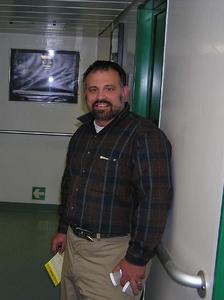
Electronics technician Gerry Bucher.
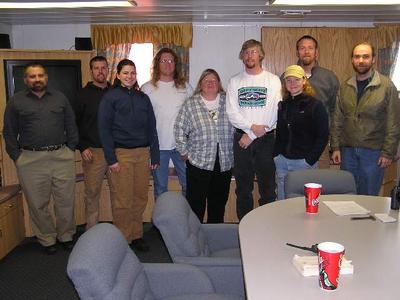
The R/V Nathaniel B.Palmer's Raytheon crew with Dr. Karl Newyear (6th from the left).
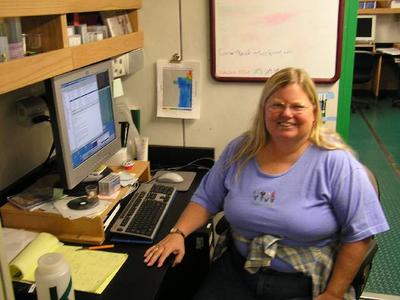
Senior Analyst Kathleen Gavahan.
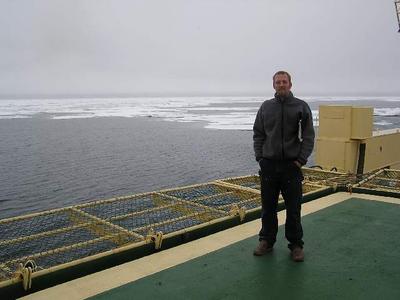
Marine science technician Eric Hutt.
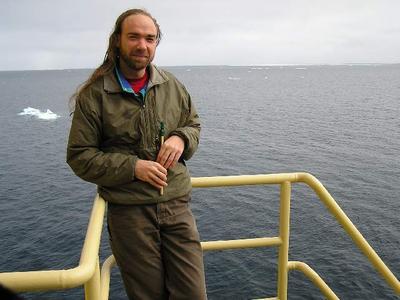
Network adminstrator Jim Waters (with tin whistle in hand).
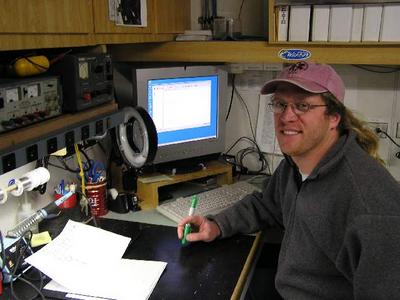
Electronics technician Brent Evers.

Marine technicians Emily Constantine (left), Jesse Doren, and Jenny White.
Contact the TEA in the field at
.
If you cannot connect through your browser, copy the
TEA's e-mail address in the "To:" line of
your favorite e-mail package.
|
